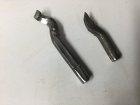Body armor? Maybe the group can recommend something stylish that goes with my Dennis Stuart Arm BraceClearly you should have been standing behind your advisee, thereby putting him first in the line of fire.
That is a good reminder that centrifugal force can wind up in unexpected places. Glad you weren't seriously hurt. Have you looked into body armor?
Can you explain how the hook tool was incorrectly presented?
So that I can properly joust the wood. Lol
The hook that we were using was the Andre Martel Hook tool see photo. If you take a traditional scraper and present it to the wood below center it will invariably catch. If you approach the wood with the tip of the AMHT it will grab wood similarly. The hook tools base is fairly thin and it will snap. See broken base. also when you teach a skill to an experienced woodturner they often get ahead of you. He didn’t even give me a chance to instruct him to rotate the tool and approach the wood with the heal of the tool. It happened in an instance.


